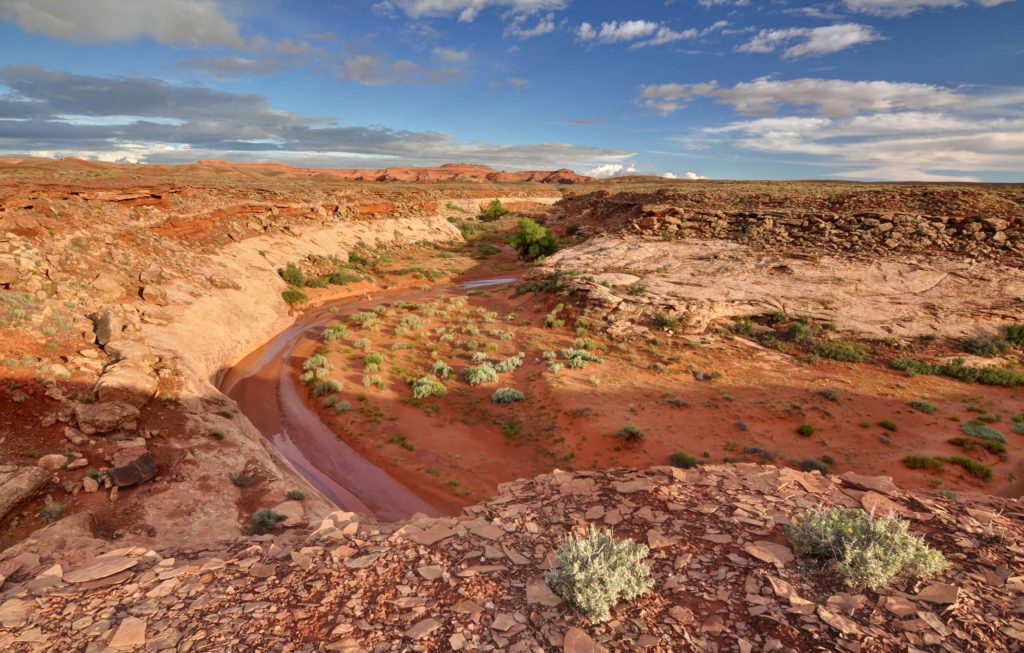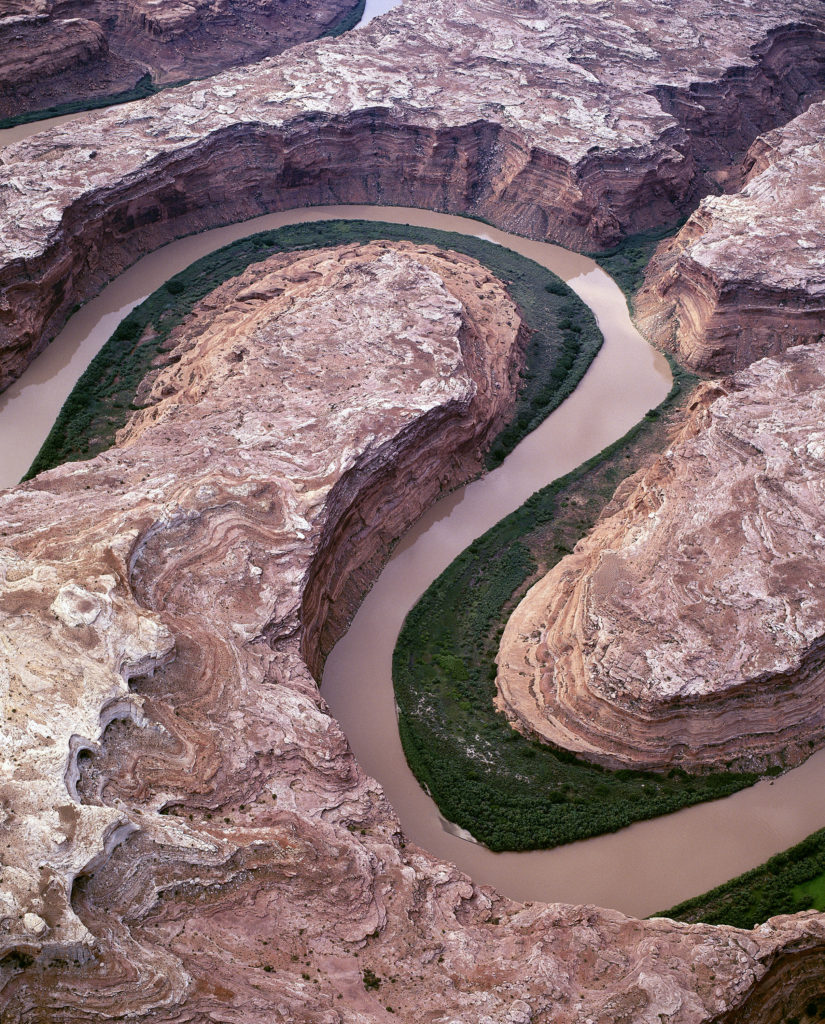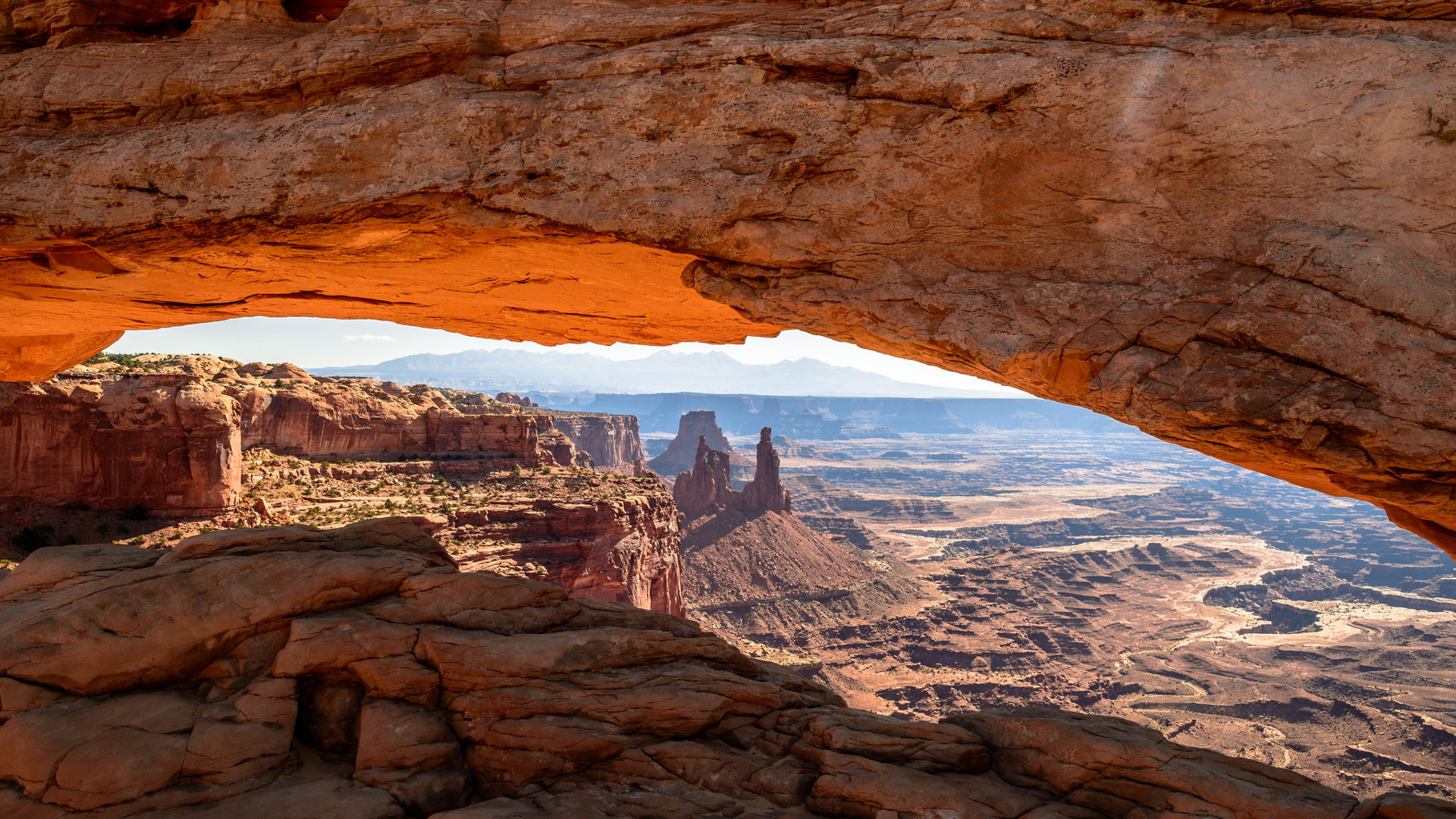Millions of acres of ecologically and culturally important public lands could face permanent damage or destruction under President Trump’s energy-dominance agenda, experts warn.
“The Trump administration’s ‘energy dominance’ agenda is prioritizing oil and gas development above all other uses of public lands,” says Laura Peterson, attorney with Southern Utah Wilderness Alliance, a nonprofit organization that seeks to protect Utah’s red rock wilderness. “In pursuit of that quixotic goal, it is sacrificing Utah’s wildest and most remote lands.”
Earlier this year the Department of the Interior ordered the Bureau of Land Management to simplify and streamline the oil and gas leasing process to lessen what it called “unnecessary impediments and burdens” on developers. The Trump administration says this is critical to America’s energy independence. Environmental experts, however, have sounded alarm over drilling in close proximity to national parks, national monuments and other areas with significant cultural, ecological and historical resources.
In Utah hundreds of thousands of acres of land previously closed to development are being auctioned off for oil and gas leasing.
The most recent leases took place this past September, when 109 oil and gas leases consisting of more than 200,000 acres of federal public land were up for grabs. Some of the parcels were less than two miles away from Horseshoe Canyon near the Canyonlands National Park and a few miles further from the Glen Canyon National Recreation Area. Horseshoe Canyon contains, according to the National Park Service, some of the most significant American Indian rock art in North America, including the Great Gallery — a world-renowned panel of well-preserved, life-sized figures with intricate designs.
Some of the September leases covered small territories, while others were quite large. Seventy-two leases spanned 158,944 acres in the remote San Rafael Desert, a scenic area with mesas, cliffs and canyons, as well as the northern Dirty Devil River area, an 80-mile tributary of the Colorado River.

All told the September oil and gas lease sale fetched over $3.3 million. The biggest buyer was a Canadian company, North American Helium, which submitted the month’s highest bid of $435,591 for a 1,970-acre lot in northwest Colorado.
Interestingly, despite being publicized as a successful sale, the September lease didn’t actually generate the anticipated interest. Only 69 out of 109 parcels were auctioned off, and many of the sites leased for bargain-basement prices. More than 40 lease parcels sold for as little as $2 per acre, while 40 parcels didn’t receive bids at all.
Peterson says the lack of infrastructure in Utah’s remote areas kept many developers at bay.
“There is little to no existing infrastructure for development and there is not a significant amount of oil and gas resource there,” she says.
But lack of oil doesn’t always translate to “no sale.” Dave Nimkin, senior regional director for the southwest region of the National Parks Conservation Association, says buyers often purposefully tie up large swaths of land without prior analysis or scrutiny. Companies and individuals then hold on to the purchased land for years, hoping it will become an asset when oil prices go up.
Utah is a prime example of this “lease and hold” strategy. At the end of the 2016 fiscal year, approximately 2.9 million acres were leased to oil and gas operators, but only about 1.1 million acres were in production.
The companies leasing the lands “are not necessarily in business of energy development,” Nimkin says. “They are really speculators looking to sell that asset for greater value than what they paid.”
Whether the sites are oil-rich or not, both recent and proposed future lease sales in Utah have included lands rich in cultural, historical, ecological and biological resources.
For example, Peterson says a March 2018 lease sale included parcels near Bears Ears, Hovenweep and Canyons of the Ancients national monuments, as well as in the Alkali Ridge and along the Green and San Juan rivers.
“That lease sale was especially egregious,” Peterson says, “because of the parcels that are incredibly rich in cultural resources — in areas like Recapture Canyon, Mustang Mesa, Alkali Ridge and Montezuma Creek. The sites in that area include ancestral Puebloan habitation sites, structures, storage facilities, short term camps, limited activity areas, petroglyphs and pictographs and artifacts.”
Drilling and a Return to Deregulation
Environmental regulations that govern oil and gas leases are an important determinant of how much drilling is allowed in a given area. These regulations have undergone significant changes over the past decade, culminating with the recent rollbacks by the Trump administration that aimed to facilitate oil and gas development in the areas that have previously been off the table.
The issue dates back to an earlier era. During the Bush administration, six “resource-management plans” — land-use plans that provide a framework for managing BLM-administered lands over the next 15 to 20 years — were completed in Utah in August 2008, sparking protests from environmental groups. Some alleged that the timing of the release was politically motivated, as the Bush administration was about to leave office, making it difficult to review the six massive documents.
The plans were ultimately pushed through in the same year, which critics say in many ways emboldened oil and gas development that had previously been subject to review and assessment.
That slowed, temporarily, under the Obama administration, when Interior Secretary Ken Salazar put a moratorium on 77 oil and gas leases that the Bush administration had granted on the doorstep of the Arches National Park.
Salazar introduced leasing reform to address a system that was close to the breaking point, with nearly half of all proposed parcels receiving community protests and a substantial proportion resulting in litigation, according to the BLM. As a result, a new tool called “master leasing plans” was launched by the agency in 2010. The plans served as guide to facilitate balanced leasing and development of energy resources on public lands while protecting wildlife, natural resources and outdoor recreation.
The lease plans engendered a stakeholder process that assessed potential impacts before formalizing the leases.
However, the Trump administration ditched master leasing plans along with all of the preliminary steps that were required before gas and oil lease sales could take place with a single goal to expedite oil and gas leases.
Compounding the problem, the BLM has recently reduced its public comment period in the lease sale process.
Before the September lease sale in Utah, the agency didn’t allow the public to comment on its environmental analysis and allowed only written “scoping comments” — a much more limited form of comment that prioritizes “substantive comments” regarding a project’s impact and ignores opinion statements — during a 15-day period in July. During that time the public had no information beyond the location of the lease parcels, according to the Southern Utah Wilderness Alliance.
It’s not just the public that’s been cut off. Nimkin says the National Park Service, the BLM’s sister agency, is now consulted only “marginally,” and even local BLM managers and state directors are often disconnected from the process.
“The ability of BLM local officials to make decisions based on their own discretion has now been taken away from them,” Nimkin says. “We are being told that virtually every deferral choice for any lease sale is being made at the highest level in the Department of the Interior in Washington, D.C.”
This lack of public comment has already proven, at least in part, to be illegal. On Sept. 21 a federal judge temporarily blocked a Trump administration policy that would have drastically limited public involvement in oil and gas leasing decisions. According to the preliminary injunction order, issued by U.S. Chief Magistrate Judge Ronald E. Bush, lease sales scheduled for December in greater sage-grouse habitat spanning hundreds of thousands of acres across the interior West must now include 30-day public comment and administrative protest periods. The injunction stemmed from a lawsuit by the Western Watersheds Project and the Center for Biological Diversity (publisher of The Revelator).
The December lease sale was supposed to be conducted in accordance with the BLM’s Instruction Memorandum 2018-034, similar to the September lease sale, which severely limited public involvement.
The BLM’s Utah office didn’t respond to numerous requests for comment seeking to find out how the agency plans to handle the December lease sale in light of the ruling.
No matter how they move forward, however, the December lease sale is poised to be the largest in Utah in more than a decade, with 225 parcels encompassing 329,826 acres of federal public lands.

That sale includes wilderness areas in Book Cliffs, the White River area, Labyrinth Canyon and Four Corners region, according to Southern Utah Wilderness Alliance.
Other parcels are located in or near culturally rich landscapes, including Nine Mile Canyon and the Alkali Ridge Area. In addition, there are 159 parcels in the Uinta Basin, a geologic structural basin in the eastern part of the state that already suffers from some of the worst air quality in the nation because of increased oil and gas development. Environmental experts are worried that those problems will only worsen with expanded energy development.
In addition, tourism and outdoor recreation, which generate $12.3 billion a year in Utah, could be at risk. Peterson fears that tourists and outdoor recreation enthusiasts are not going to come “to explore pump jacks and pipelines.”
Just Warming Up
Looking further ahead, the BLM recently released a draft “resource management plan” that would open to development 2 millions of acres in southeastern New Mexico, where deposits of oil are said to be second only to Saudi Arabia.
While the plan would allow developers to tap large deposits of oil in the region, which includes part of the Permian Basin, critics say the passage of this first major resource management plan under the Trump administration could also pave the way for the unrestricted energy development in other western states.
The BLM’s Carlsbad field office, the busiest in the nation for oil and gas drilling, is in the middle of the resource plan revision process. A draft published Aug. 3 would determine how the region’s resources will be managed for the next 20 years. The draft features four alternatives for development of oil, natural gas and mineral extraction with the overarching goal of balancing the extraction industries with preservation of natural resources and public lands, according to the Carlsbad Current Argus.
Judy Calman, staff attorney at New Mexico Wilderness Alliance, a nonprofit dedicated to protection of New Mexico’s wilderness areas, says there’s a lot of pressure on the Carlsbad field office from the Trump administration and from the companies who want to develop the area.
“I think the field office is seeing a lot of direction from D.C. about what kind of decisions to make, and I think it’s like a microcosm of the Trump administration’s energy policy,” she says.
The draft covers numerous ecologically important regions, including more than 130,000 acres bureaucratically defined as “lands with wilderness characteristics,” which have been documented during separate inventories conducted by the BLM and the New Mexico Wilderness Alliance.
Although these lands have been determined to meet the BLM’s wilderness characteristics criteria, this alone does not guarantee they will be preserved. The agency can formally recognize these areas and can also decide to manage them for preservation. Without recognition, these lands will be up for grabs for oil and gas companies, according to the Wilderness Alliance website.
Separately the New Mexico Wilderness Alliance has proposed four new Areas of Critical Environmental Concern — units of public land spanning over 550,000 acres that protect important grassland habitat for birds of prey, riparian ecosystem components, nest colonies for great blue heron and culturally significant salt playas from fast-track oil and gas development.
In certain situations this type of designation can provide additional protection for lands that do not qualify as having wilderness characteristics but nonetheless are important for their wildlife, cultural or other resource values, according to the Wilderness Alliance website.
Of special concern is Carlsbad Caverns National Park, which famously boasts more than 100 miles of caves. Oil and gas development can already be seen from the park, and research is still being conducted on the network of caves inside and outside the caverns regarding the potential impacts that oil and gas development may have on the park.
About 75 percent of land managed by the Carlsbad field office is either already under development or about to be developed because it has been leased. In 2018 the office received 1,533 applications to permit drilling — the highest number in 10 years.
Calman says while the proposed plan is still under review her organization is trying to protect whatever little is left undisturbed.
“The Trump administration has this energy dominance thing and it seems like it’s playing out here in southeast New Mexico,” Calman says.
Unlike the oil and lease sales, the proposed resource management plan still had a public comment period, which closed on Nov. 6. The BLM also held eight public meetings across New Mexico in September.
The plan was in actually the works under the Obama administration for eight years, but the Trump administration has proposed to include areas that were previously closed to development.
According to a report by High Country News, the Carlsbad Field Office initially planned to protect certain areas for wildlife scenic or cultural values that are not included in the new version. For instance, maps drafted in 2016 show that the BLM’s preferred alternative included more extensive protection for grasslands west of Artesia, a town with a population of 12,000 people.
The BLM’s New Mexico office also didn’t respond to numerous requests for comment regarding how the organization plans to address environmental concerns and when the agency plans to finish the proposed resource management plan.
Some worry that with its passage the agency will prioritize oil and gas development over managing the area for multiple use, meaning the country will see a major shift in public-land management.
The 90-day public comment period on the draft resource management plan started Aug. 3 and closed Nov. 5. Calman says throughout that period, her organization was still trying to convince the BLM to make changes to the document and prioritize conservation over development.
“This is the first one,” Calman says. “I think it’s a good opportunity to stop it before it gets rolling too much.”
But other projects loom not far behind, and that could have a lasting impact. “In its quest for energy dominance, the administration is leasing more remote, wild and sensitive areas,” Peterson says. “That push is both unnecessary and misguided. Once these sensitive landscapes are gone, we cannot get them back.”
© 2018 Daria Bachmann. All rights reserved.


